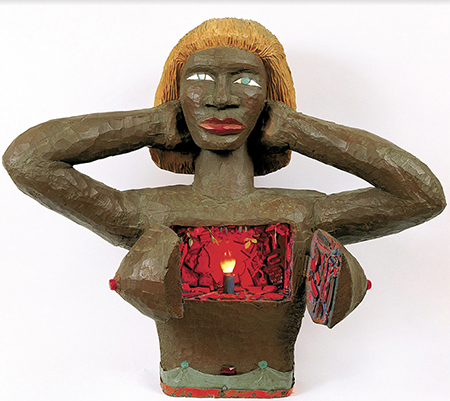
Continuing through December 12, 2021 (Armory)
Continuing through December 19, 2021 (Benton Museum)
While some art exhibitions are smart, stimulating, and easy on the eyes, others simply demand to be seen. L.A. born and based Alison Saar’s two-part exhibition, “Of Aether and Earthe” falls into the latter category. This review focuses on the Armory installment, which explores the energies of fire and air. “Earthe” at the Benton mines the chthonic powers embedded in earth and water. The work in both shows focuses on African American women and their bodies, exploring contemporary understanding of gender, race, and social and political oppression.
The Armory has done a wonderful job in hanging this show, which consists of fourteen mixed media pieces. Fourteen works also comprise the Benton’s exhibition, which in addition to Saar’s sculptures includes paintings and drawings. Together the shows serve as a survey of Saar’s long and productive career, bookended with pieces made at its beginning in the early 1980s and concluding with a large room-sized installation at the Armory, completed this year and shown here for the first time.
The 1985 “Sapphire,” represents the earliest work in the Armory show. Muscularly carved out of wood and signaling the organicism and long tradition of African sculpture, the piece also blends, both surrealistically and somewhat absurdly, Anglican accents of blond hair and blue eyes that the artist has grafted onto the bust of her dark-skinned woman. The figure’s breasts, mounted on hinges, are swung open to reveal the red inner chamber of her chest, which is illuminated by a single perfectly centered light bulb. Saar employs an almost Gothic vocabulary in her interpretation of the vaudeville-era caricature known as “Sapphire” that depicted Black women as over-sexualized objects with domineering personalities. The artist subverts the stereotype and restores this woman’s humanity via an array of personal objects hung or placed inside of Sapphire’s glowing body. One finds a wristwatch, a carved figure of a lizard, a toy ballerina, a small mauve colored sculpted dove, all hand painted and suggestive of the flotsam, prized possessions and eccentric obsessions of an individual’s life who is determined to live unshackled by society’s depersonalizing and conforming pressures.
Alternately fragile and sturdy, many of Saar’s pieces present Black women in the midst of dynamic motions of acrobatic grace. Nowhere does this balancing act achieve greater equilibrium than in “Brood,” a totemic work in which a Black woman configured in fiberglass and bronze sits precariously on top of a stack of found children’s chairs. The figure sits Thinker-like on the top chair and peers through the fingers of her opened hands back over the foundations of her childhood, perhaps figuratively mourning an unresolved past. She is also tracing the trajectories of objects she has dropped, which are strewn on the gallery’s floor in the form of sculpted pomegranates, symbols of beauty, fertility, life and death in diverse cultures around the world.
In this and other works Saar elevates her women high above the gallery floor. The altitude provides a wide perspective that invests the women with an authority to pass judgment over the myriad ignominies and criminal cruelties that African Americans have had to endure for centuries.
“Hygiea,” the show’s largest and most recent piece, responds to the global Covid 19 pandemic and crisis. It is a mixed-media installation that occupies a hallway-shaped room at the back of the gallery. Gazing into it, we encounter a large wood sculpture of Hygiea, the Greek goddess of health, cleanliness and sanitation. She is imagined here as a charwoman holding a double-headed broom and cradling a white snake. Hygiea glares back at her onlookers, her lips painted a cold, fierce and frightening blue. The sounds of dripping water kerplunk into tin buckets strewn across the floor. A scattering of bare, randomly hung light bulbs project a ghostly and foreboding hue that provides the finishing effect on a synesthetic piece is at once cinematic and evocative of folk art.
The same serpent that in Genesis tempted and betrayed Eve here promises to shed its skin in a symbolic gesture of healing and renewal. Similarly, the broom eschews its cliched association with witches to become a rifle that Hygiea aims at cleaning up and wiping out not only this pandemic, but the even more insidious demons of systemic racism until both have vanished from the face of the earth.
